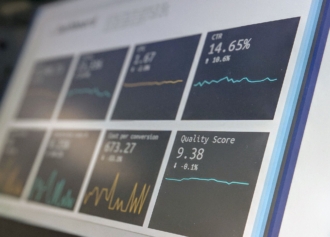The best-selling productivity author David Allen called it Getting Things Done.
Malcolm Gladwell, researcher and writer about the wonderful weirdness of human psychology, coined the “10,000 hour rule.”
But perhaps neither method for maintaining momentum has been adopted as fiercely as an off-the-cuff remark made by comedian Jerry Seinfeld over a decade ago:
Don’t break the chain.
“He said for each day that I do my task of writing, I get to put a big red X over that day. After a few days you’ll have a chain. Just keep at it and the chain will grow longer every day. You’ll like seeing that chain, especially when you get a few weeks under your belt. Your only job next is to not break the chain.”
Don’t break the chain.”
Not breaking the chain leads to momentum. And momentum isn’t mystical. Science defines it as the force that allows something to grow stronger or faster as time passes.
However, momentum isn’t the only science at work in our daily lives. Like everything else, it must have an equal and opposite reaction.
The enemy of momentum: how friction breaks your chain
Friction is the resistance caused when one object is moving at a different rate than another.
And what is life if not an infinite number of distracting meetings, ideas, goals, people, projects, emails, meetings, chores, and commitments all moving at a different rate than one another?
If you can’t kill friction, it’ll eat through your momentum like rust through a chain.
However, if you can find a way to focus on building a single goal, or “chain,” and building it well — the payoff might be more rewarding than you ever expected.
I’ve spent 12 years building my chain, i.e., building Jotform.
Back in my dorm room in 2006, I could never have predicted that such momentum would enable me to grow my startup to 3.5 million users and +108 employees today — without receiving a single dime of outside funding.
Sustained momentum toward a singular goal creates a compound effect. Which is, in essence, the concept that consistent, incremental changes can result in fundamental changes over time.
Between the ages of 32 and 44, Warren Buffett grew his net worth by 1,257 percent. But it’s the next 12 years that are truly astounding.
From 44 to 56, he grew his net worth by 7,268 percent.
Slowly but surely, he started building up a chain of investments and never stopped.
“Where I’d had huge success, I had narrowed my concentration to one thing, and where my success varied, my focus had, too … Success is sequential, not simultaneous.”
– Gary Keller and Jay Papasan, Authors of The One Thing
However, achieving your goals isn’t all a matter of balancing delicate scientific principles against one another.
There are also several interesting psychological factors that come into play.
It all started at the car wash.
As described in their paper The endowed progress effect: how artificial advancement increases effort, researchers Joseph C. Nunes and Xavier Drèze set up shop at a professional car wash to find out just how loyalty programs motivated consumers to buy more.
Each car wash customer was presented with a card promising a free wash after they collected eight stamps. Some cards only had spaces for eight stamps while others had spaces for 10 but two had already been stamped.
The answer they found might help explain why we intrinsically feel motivated when we see a long line of “Xs” in our chain:
34 percent of those who perceived they had a head start redeemed their ninth free wash.
Only 19 percent of those who started with completely blank cards redeemed theirs.
This endowed progress effect shows that a person who perceives progress toward a goal is more likely to complete it, and faster, than a person who feels they’re starting from scratch.
In addition, another psychological factor dubbed the goal visualization effect ramps up momentum even further once the end goal is in sight, as Amar Cheema and Rajesh Bagchi explained in their research about The Effect of Goal Visualization on Goal Pursuit:
“…as people approach a goal, external representations, which increase the ease of visualizing the goal, enhance goal pursuit. Specifically, consumers judge easy-to-visualize goals to be closer than difficult-to-visualize goals, which in turn increases effort and commitment.”
As Cheema and Bagchi further suggest, managers can use these results to enhance consumer goal pursuit, influence consumer satisfaction in online service encounters, and motivate employees to improve performance.
Making goals visually attainable — especially more abstract ones such as launching a digital product or even improving your mindset — provides more motivation for reaching them.
That visualization is exactly what Seinfeld so prophetically touched on years ago with his “Don’t break the chain” advice.
And it’s exactly what people, including myself, are still doing to this day to hone in on their goals and build an unstoppable chain of momentum that compounds on each and every achievement.
Here’s the process I’ve developed to focus on what needs doing, planning just how I’ll get it done, and developing an addiction to the momentum that gets me there even when life so oft gets in the way.
1. Preserve your chain in a friction-filled world
It all starts with defining the purpose of your chain. Most people would call this defining your one goal, i.e., your single focus.
While I don’t think goals are inherently wrong to have, I do think they can sometimes have a negative impact — especially those unrealistic and short-sighted goals.
Aiming to read 50 books by the end of the year is a goal, while carrying a book with you at all times is a habit.
I believe in developing healthy, long-term habits instead. What I’ve found hugely helpful for reflecting on the progress of your chain every single day is scheduling uninterrupted times into my day.
At Jotform, I’ve two preset hours for focus time every single morning. During these two hours, I open a blank document and start writing about a problem I want to tackle that day or something that’s on my mind.
It often begins as an incoherent stream-of-consciousness, but after about five minutes, I start to develop new ideas. I find clarity in the chaos.
Once my writing period is over I often find that I was able to clarify an idea I hadn’t been able to express, solve a problem, write a new blog post, or come up with a presentation for the team at our next Demo Day.
Seeing my chain get longer gives me more momentum to keep up this habit that has a lasting, positive impact beyond simply boosting Jotform’s bottom line an eighth of a percent.
2. Choose your tools — marker not required
A decade ago and for a professional comedian, a giant wall calendar and a fat red marker made a lot of sense. But in today’s environment, don’t feel shy about pursuing your chain using whatever tools make sense to you.
Some might like to use a digital calendar much the same way you’d use an analog one to create a visual representation of completing a task. Others might like the satisfaction of checking a recurring item off a virtual to-do list.
In addition to tools that help track your progress, you can also develop several habits that can help you to keep on top of daily priorities.
For instance, every night before I shut down my computer, I make sure to visit my Google Chrome settings (try chrome://settings/ to find it in your browser) and personalize the pages that open on startup.
When I launch my browser the following morning, I know the pages that pop up will help me continue my chain — whether the goal is to write a new blog post or to fix one bug in the code.
I also stay committed to Inbox Zero without letting my notifications control me. My team knows I won’t respond to their messages immediately, but I will reply (fully and thoughtfully) within one business day.
Every few hours, I scan my inbox to see if there is any urgent email. And only toward the end of the day, I spend an allotted amount of time addressing every single email I’ve received.
3. Create outcome-based requirements for every link you add to the chain
I’ve found that the standards by which you’ll judge forward momentum on your goal are most effective if they’re outcome-based instead of time-boxed.
For example, one of my personal goals in recent years has been to improve my physical health so I can be present for my employees and my family for many years to come.
I don’t let myself off the hook for simply spending 30 minutes wandering around the gym making excuses about how I’m too tired to do my cardio workout.
Instead, I only let myself put another proverbial “X” on the calendar when I complete a personal training session.
4. Set reasonable boundaries that keep you on track, not scare you away
Not all of us can devote big chunks of time, every single day in a row, to completing projects — especially the bigger and hairier they are.
If you’re working toward a reasonable, achievable goal it only makes sense that your timeline be just as reasonable and achievable.
I’ve spent over a decade bootstrapping my company from the ground up — and I couldn’t have done it without taking breaks to keep myself and my employees sane.
At Jotform, we plan ahead for and encourage regular working hours, vacations, and sick days as needed.
I don’t consider this to be cheating nor breaking the chain. Instead I think of it as a way to ensure we don’t break the chain by staying happy and healthy enough to work hard every single day we’re at work.
If you still crave that mark on the calendar, replace your “X” with an “S” for sick day, a “V” for vacation, and so on.
By understanding reasonable boundaries and knowing how and when to flex, we’re also able to retain the agility that’s absolutely necessary in a user-centric business.
Giving ourselves a pat on the back for achieving our goals can feel great but Seinfeld’s wisdom about momentum reminds us the importance of building healthy, long-term systems.
The science and psychology are on our side. We can use them to fight friction and build a chain that develops healthy habits and compounding effects for a better personal and professional future.

















Send Comment: